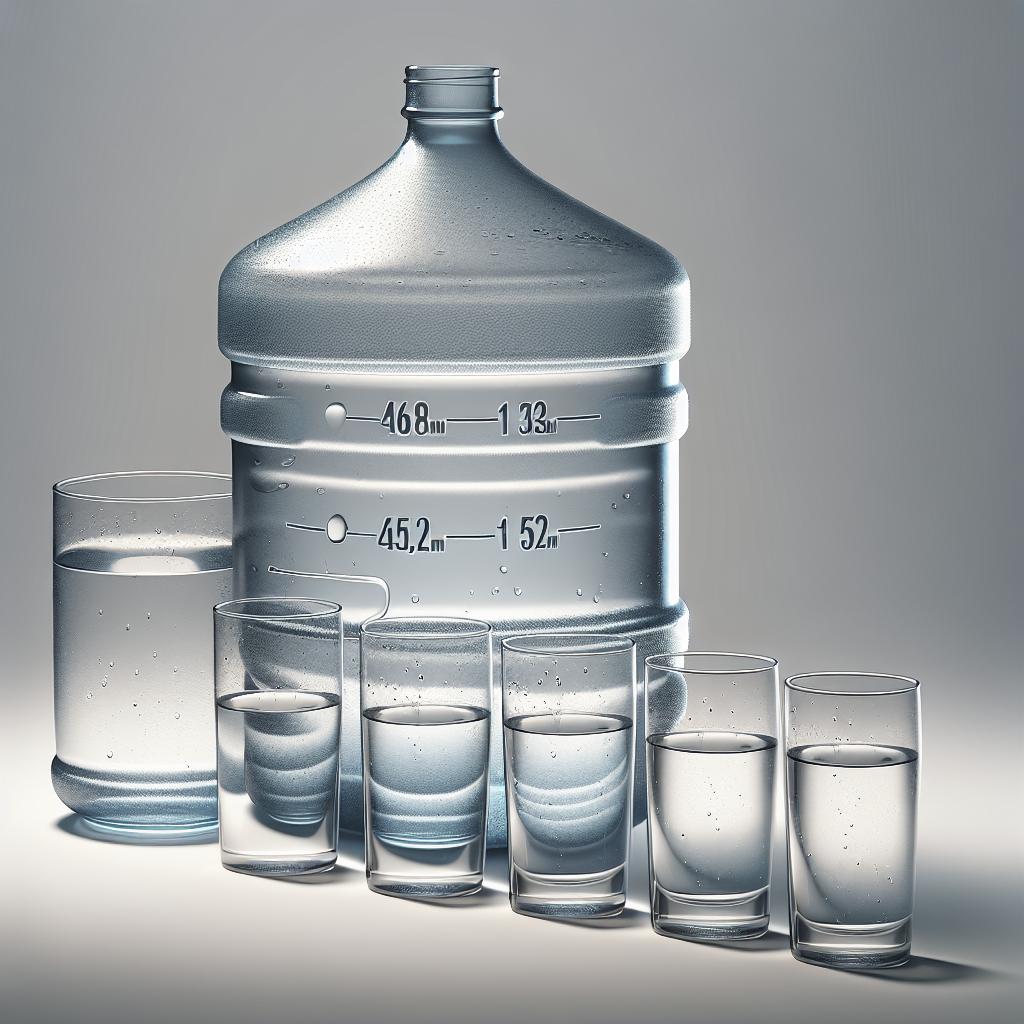“`html
How Many Glasses of Water Is a Gallon?
Water intake is a crucial component of maintaining a healthy lifestyle, yet determining exactly how much water to drink can be confusing. Terms like gallons, liters, and water bottles often muddle the promise of staying appropriately hydrated. In this comprehensive guide, we’ll explore the significance of measuring water intake, provide clarity on how many bottles make a gallon, and offer practical hydration tips. We’ll delve into various measurement comparisons, help you understand daily intake recommendations, and discuss the benefits of knowing your water consumption. By the end, you’ll have an informed perspective to confidently manage your hydration habits.
Why Is Measuring Water Intake Important?
Measuring water intake ensures that your body gets the necessary hydration it needs for optimal function. Dehydration can lead to fatigue, headaches, and impaired physical performance. By keeping track of how much water you drink, you can prevent these issues and support bodily functions such as digestion and temperature regulation.
For athletes, the elderly, or anyone in a hot climate, monitoring water intake becomes even more essential. Certain conditions like diabetes or kidney problems may also require precise tracking of fluid intake. Understanding how much water a gallon holds and how to translate that into daily consumption helps you maintain consistent hydration levels, contributing significantly to general well-being.
Understanding Gallon Measurements
A gallon, a unit of measure commonly used in the United States, equals 128 fluid ounces. In other parts of the world, a gallon might have different values, so it’s vital to be clear about this standard. When people talk about gallons in the context of water consumption, they are usually referring to this measurement.
Understanding gallon measurements is foundational for translating recommended water intake into relatable, daily use instances, particularly when considering how many glasses or bottles of water comprise a gallon. The ability to convert this unit into smaller or easier measurements like cups and bottles helps with practical drinking goals throughout the day.
Recommendations for Daily Water Intake
The widely referenced recommendation is to drink eight 8-ounce glasses of water daily, known as the “8×8 rule.” However, water needs vary by individual based on factors such as activity level, climate, and overall health. Consulting a healthcare provider can offer more tailored guidance.
Emerging advice suggests aiming for a fluid intake of approximately 11.5 cups (2.7 liters) daily for women and 15.5 cups (3.7 liters) for men, considering all fluids consumed. With water as a crucial part of the hydration equation, converting these recommendations into gallons aids in monitoring and achieving necessary intake.
How Many Bottles of Water Is a Gallon?
How many bottles of water is a gallon?
A standard water bottle typically contains 16.9 fluid ounces. To calculate how many such bottles make up a gallon, divide 128 fluid ounces (one gallon) by 16.9 ounces per bottle. The result is approximately 7.57 bottles of water per gallon.
How many water bottles make a gallon?
Since a gallon holds 128 ounces, understanding the number of standard bottles required helps visualize daily consumption. If you’re using 16.9-ounce bottles, drinking 8 bottles fulfills a gallon, offering a straightforward metric to ensure adequate hydration.
How many bottles of water should you drink a day?
Depending on personal needs, consumption of bottled water varies. For someone aiming for a gallon a day using 16.9-ounce bottles, a target of around 8 bottles keeps them hydrated, although individual factors may adjust this suggestion upwards or downwards.
Is a Gallon of Water Enough for Daily Intake?
Drinking a gallon of water daily works well for many but isn’t a universal necessity. While this benchmark provides an easily trackable goal, varying activity levels, environmental conditions, and dietary considerations immensely influence personal hydration needs.
Always consider personal thirst signals alongside guided recommendations, and consult with healthcare professionals for advice based on specific health conditions or situations, especially when engaging in activities that significantly increase sweat loss.
How Many Water Bottles Are 2 Liters?
How many water bottles are 2 liters?
To understand how many standard 16.9-ounce bottles make up 2 liters, it helps to know that 2 liters roughly equal 67.6 ounces. Thus, 2 liters approximately fill 4 standard water bottles.
How many bottles of water equal a gallon?
Since a gallon consists of 128 ounces, calculating the number of a 16.9-ounce bottle per gallon yields approximately 7.57 bottles per gallon. Thus, drinking 8 water bottles satisfies a gallon daily goal.
How many liters are in a bottle of water?
A standard bottle of water, containing about 16.9 ounces, holds approximately 0.5 liters. Understanding this equivalence helps when purchasing or consuming water internationally or when dealing with diverse unit systems.
How Many Cups Are in a Water Bottle?
How many cups are in a water bottle?
With a standard cup defined as 8 ounces, a typical 16.9-ounce water bottle equals about 2 cups of water. Recognizing this conversion aids in tracking consumption, especially when following the “8 cups a day” rule.
Benefits of Measuring Water Intake
Regularly measuring water intake promotes mindful hydration which can enhance physical performance, support digestion, maintain skin health, and prevent kidney stones. Hydration-conscious individuals often experience improved cognitive function and mood stability.
Proper water consumption can aid weight management by reducing perceived hunger pangs, helping differentiate between hunger and thirst. Thus, judiciously tracking water intake serves various health benefits alongside its primary role in bodily function support.
Practical Tips for Staying Hydrated
To stay adequately hydrated, habitually drink water with meals, keep a reusable water bottle on hand, and set reminders or water goals on digital devices. Utilizing infusions like lemon or cucumber may make plain water more palatable and encourage consumption.
For individuals who struggle with tracking, apps are available to log fluid intake by alerting when to drink, helping transition water-drinking into a daily routine more seamlessly. Customizing your hydration method ensures consistency without monotony.
How Long Is Bottled Water Good For?
How long is bottled water good for?
Bottled water often includes an expiration date, which typically indicates when optimal freshness may decline, not necessarily when it becomes unsafe to drink. Most bottled water remains safe past this date if stored in a cool, dark location.
Opened bottles should be consumed quickly, ideally within a few days, to avoid bacterial growth. Always check for unusual odors or tastes, which could signal deterioration or contamination.
How Many Gallons Are in a Water Bottle?
How many gallons are in a water bottle?
A standard 16.9-ounce bottle contains approximately 0.133 gallons. This knowledge helps when calculating the total gallons needed for daily intake, aiding particularly when personalizing water consumption goals.
Lessons Learned
| Topic | Summary |
|---|---|
| Measuring Water Intake | Important for maintaining health, preventing dehydration, and supporting bodily functions. |
| Daily Water Needs | Varies by individual; generally 2.7 liters for women, 3.7 liters for men. |
| Water Bottles in a Gallon | Approximately 7.57 bottles of 16.9-ounce water make up a gallon. |
| Maintaining Hydration | Incorporate regular intake throughout the day using reminders and flavored water. |
FAQs about “How Many Bottles of Water Is a Gallon?”
How much water should I drink a day?
While popular guidelines suggest eight 8-ounce glasses daily, personal hydration must consider lifestyle, activity level, and climatic conditions. Averages are 2.7 liters for women and 3.7 liters for men, including all fluid sources.
“`

